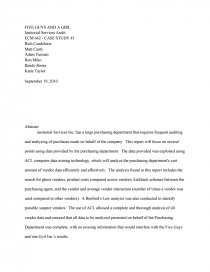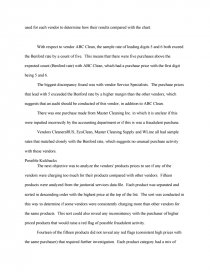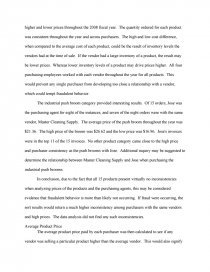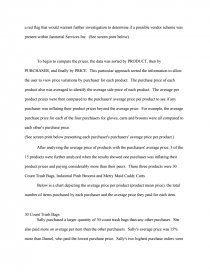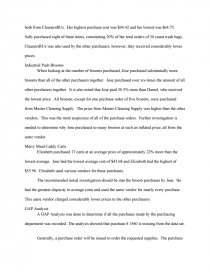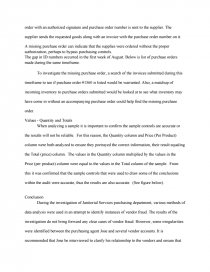Ecm 642 - Janitorial Services
Essay by Kill009 • September 21, 2011 • Essay • 2,120 Words (9 Pages) • 1,727 Views
FIVE GUYS AND A GIRL
Janitorial Services Audit
ECM 642 - CASE STUDY #1
Rich Candelaria
Matt Canty
Adam Furman
Ron Miko
Randy Reese
Katie Taylor
September 19, 2010
Abstract
Janitorial Services Inc. has a large purchasing department that requires frequent auditing and analyzing of purchases made on behalf of the company. This report will focus on several points using data provided by the purchasing department. The data provided was exploited using ACL computer data mining technology, which will analyze the purchasing department's vast amount of vendor data efficiently and effectively. The analysis found in this report includes the search for ghost vendors, product costs compared across vendors, kickback schemes between the purchasing agent, and the vendor and average vendor interaction (number of times a vendor was used compared to other vendors). A Benford's Law analysis was also conducted to identify possible suspect vendors. The use of ACL allowed a complete and thorough analysis of all vendor data and ensured that all data to be analyzed presented on behalf of the Purchasing Department was complete, with no missing information that would interfere with the Five Guys and one Gyrl Inc.'s results.
Vendors with Similar Names
Using the data set provided by the janitorial services, information was imported into the ACL software analysis program to analyze the different vendor names and look for similarities that might indicate a ghost vendor was present. Two vendors had similar names: Master Cleaning Inc. and Master Cleaning Supply. Data analysis of the results shows that it is possible that Master Cleaning Inc. may be a phantom vendor.
Below is a snap shot of the results of the vendor name summary that includes a summary of the purchaser and a count of how many times the vendor was used.
Benford's Law & Product Prices
The product price column of the data set was then analyzed according to Bedford's law. Benford's Law is named after Dr. Frank Benford, who was a physicist for the General Electric Company. After conducting a statistical analysis of large data sets, Dr. Benford concluded that the frequency of the first digit in a data set decreases as it goes from 1 to 9. Dr. Benford's tests reveal that the first digit of 1 occurred 30.1 percent of the time, with the first digit of 2 occurring 17.6 percent of the time, and continues to decrease to 4.6 percent for the first digit of 9.
To test Benford's Law on the data set (the Janitorial Purchases spreadsheet), a formula was created that represents Benford's Law. The results were then displayed in a graph. The graph below represents a combination of all 919 purchases. The results show that the first digits in the purchase price that do not agree with the Benford Rate are 1, 4, 5 and 6. The sample rates of the purchase prices that start with 1 are actually lower than the Benford Rate. As the sample rate is lower than the Benford rate, this does not raise a red flag. On the other hand, the sample rates of the first digits of 4, 5 and 6 are higher than the Benford rate, which does raise a red flag.
Once it was identified which of the nine first digits needed to be focused on a filter was used for each vendor to determine how their results compared with the chart.
With respect to vendor ABC Clean, the sample rate of leading digits 5 and 6 both exceed the Benford rate by a count of five. This means that there were five purchases above the expected count (Benford rate) with ABC Clean, which had a purchase price with the first digit being 5 and 6.
The biggest discrepancy found was with vendor Service Specialists. The purchase prices that lead with 5 exceeded the Benford rate by a higher margin than the other vendors, which suggests that an audit should be conducted of this vendor, in addition to ABC Clean.
There was one purchase made from Master Cleaning Inc. in which it is unclear if this were inputted incorrectly by the accounting department or if this is was a fraudulent purchase.
Vendors CleanersRUS, EcoClean, Master Cleaning Supply and WLine all had sample rates that matched closely with the Benford rate, which suggests no unusual purchase activity with these vendors.
Possible Kickbacks
The next objective was to analyze the vendors' products prices to see if any of the vendors were charging too much for their products compared with other vendors. Fifteen products were analyzed from the janitorial services data file. Each product was separated and sorted in descending order with the highest price at the top of the list. The sort was conducted in this way to determine if some vendors were consistently charging more than other vendors for the same products. This sort could also reveal any inconsistency with the purchaser of higher priced products that would raise a red flag of possible fraudulent activity.
Fourteen of the fifteen products did not reveal any red flags (consistent high prices with the same purchaser) that required further investigation. Each product category had a mix of higher and lower prices throughout the 2008 fiscal year. The quantity ordered for each product was consistent throughout the year and across purchasers. The high and low cost difference, when compared to the average cost of each product, could be the result of inventory levels the vendors had at the time of sale. If the vendor had a large inventory of a product, the result may be lower prices. Whereas lower inventory levels of a product may drive prices higher. All four purchasing employees worked with each vendor throughout the year for all products. This would prevent any single purchaser from developing too close a relationship with a vendor, which could tempt fraudulent behavior.
The industrial push broom category provided interesting results. Of 15 orders, Jose was the purchasing agent for eight of the instances, and seven of the eight orders were with the same vendor, Master Cleaning Supply. The average price of the push broom throughout the year was $21.36. The high price of the
...
...
